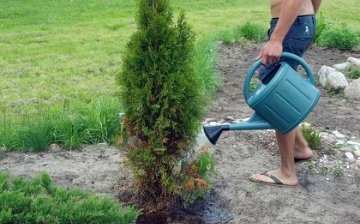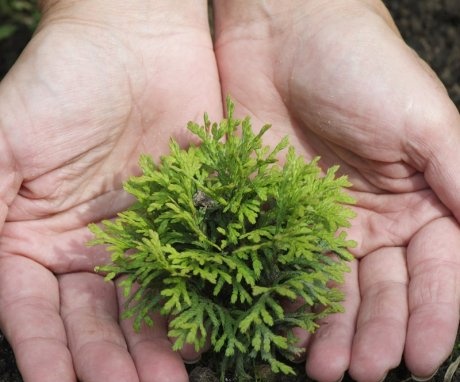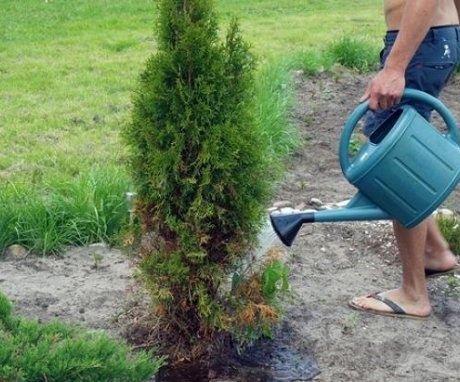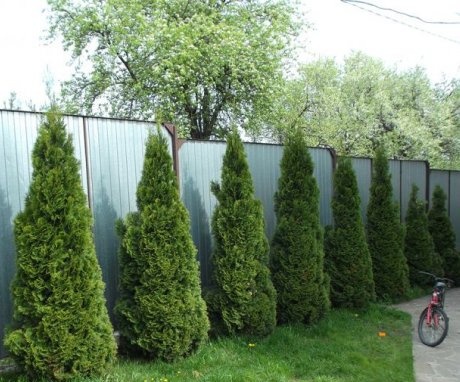Thuja fall care guide for beginner gardeners
Thuja arrived in our region from the east of North America. Because of its appearance, it is often used as an ornamental tree for decorating a summer cottage. A coniferous plant can hardly be called whimsical, but in order to maintain a beautiful and neat appearance, it must be thoroughly looked after, it is especially important to care for the thuja in the fall in preparation for the cold period.
Shrub care rules
Despite the fact that the shrub is considered frost-resistant, it also needs to be prepared for winter. With the help of the following guidelines, you can keep the plant healthy so that it will delight its owners for several decades.
Watering
Moisture evaporates at any time of the year and at any temperature. Therefore, the plant can dry out easily after wintering. With a large loss of moisture, the bark will weaken, begin to wrinkle, and the branches will become fragile and easily break in the spring. To avoid this, the plant is watered abundantly before the first frosts.
It will take 5 to 8 buckets of water for the shrub to feel normal. This volume is enough to moisten the earth to a depth of 1.5 meters. Note that the taller the tree, the more water you need! But even small specimens, water abundantly if the planting time is current or last year. Young trees absorb more moisture due to their abundant growth.
Important! Do not overdo it with watering, because excess water will cause the roots of the plant to rot. How to test the soil: Take a small amount of soil and squeeze in your hand. Under normal conditions, small amounts of water should flow down the hand.
Top dressing
Autumn feeding is necessary thue, it must be carried out according to the following rules:
- No later than mid-September. The most favorable time is mid or late August.
- Do not use nitrogen or potassium micronutrient fertilizers later than August, so as not to induce active growth.
- For better soil enrichment, compost, peat or wood ash are used. Fertilizers are used to feed the root system so that the shrub can easily endure frosts.
Mulching
Mulching is the warming of the soil under the plant with the help of auxiliary materials. These include:
- sawdust;
- straw;
- compost;
- chopped nutshells.
Auxiliary materials will prevent weeds from growing and retain moisture in the soil. Mulch can also be used as a decorative element by purchasing specially colored sawdust.
Pruning
Pruning can be done at any time when the average daytime temperature does not drop below + 4 ° C. It is not necessary to carry it out right before frost, as the tree takes some time to recover the cut branches.
The following goals are pursued:
- Updating the appearance. That is why dry branches and bark, which have been affected by parasites, are carefully removed. If you find some dried up needles, do not cut off the branch, but remove them by hand.
- Crown formation. Since thuja is an ornamental plant, this point is important. If you cut dry and pest-damaged branches in a timely manner, the tree will receive more nutrients, from this the crown will become more magnificent, and the color will be richer.
- Protection from pests. The sooner you cut off the infected branches, the easier it will be to deal with the insect attack.
Treatment against pests and diseases
If there are signs of disease or pests on the thuja, timely treatment is necessary. Otherwise, the tree will die. Each lesion has its own medicine:
- False scale or fungus. Fundazol or Rogor is used.
- Speckled moth and aphid. Spraying with Cypermethrin (additionally destroys mosquitoes in the area).
It should be noted that treating diseases of conifers is quite simple. The main thing is to find it at the stage of inception, and spring is considered the main time for development.
Young plants can be sprayed with Epin, which helps the formation of the root system and makes it easier to take root when planting.
How to prepare a thuja for wintering in the fall
Preparation for wintering is an important stage for the development of thuja's life. The main task is to preserve the life of the plant without transplanting. In the first years of life, you need to be especially careful, since the plant has not fully taken root and may freeze.
Shelter rules
During shelter for the winter, you need to take care not only of the roots, but also of the crown. To do this, follow the mandatory steps:
- The root soil is mulched along the entire perimeter. For this, the materials are laid in a layer not exceeding 20 cm. The thickness is determined based on the weather conditions in a particular region.
- Small trees are covered with bottles. In order for the thuja to enter without problems, the neck is cut off and carefully dressed over the young plant.
- Mature trees are wrapped with thick paper. Lutrasil and spunbod are also suitable. They are secured with a rope or twine as securely as possible so that the cover does not slip.
- Cleaning from sediments. To prevent the branches from breaking from the load, they are regularly cleaned.
- Removing the cover. It is carried out only after the established spring heat, the recommended average daily temperature is not lower than 4 ° C.
The level of development in the next year depends on the quality of the work performed.
Root system preparation
Before wintering, it is important to thoroughly prepare the thuja root system for the cold, this will require:
- Water every 3-4 days with 8 liters of water. The procedure is carried out until the first frost.
- Loosen the soil. It will increase the access of air to the plant. The soil is loosened no more than 10 cm deep.
- Weed weeding. To ensure the full development of the tree.
- Top dressing with mineral complexes. The poorer the land, the more fertilizer will be required.
- Protection of young plants. The ephedra are covered with medium-thick burlap.
These rules are required, otherwise the plant will not be bright and lush next year.
What problems can arise and how to solve them
Gardeners with little experience with conifers can make a lot of mistakes when preparing for winter. As a result, the tree will dry out or rot. Here are the most common options:
- Thuya begins to shed the needles. This is due to insufficient moisture. In this way, the tree tries to reduce the load in order to preserve at least the trunk. In this case, you should not dramatically increase the amount of watering. Moisturize gradually, incrementally. As a result, 1 watering should take from 5 to 8 liters of water.
- Turns yellow. Dying off occurs every 3-5 years, which means that the branches just need to be cut off. It is best to carry out the procedure in the spring. If yellowing occurs after winter, then this is a consequence of sunburn and lack of nutrients. In this case, the old branches are carefully cut off and top dressing is done, after which a quick recovery occurs.
- The bark is cracking. Occurs due to rapid growth or the presence of pests. The plant is fed with phosphate-potassium fertilizers or covered with garden balsam. For pests, they are treated for 7-10 days with Fufan or dandelion infusions.
With a correctly defined problem, it will be possible to quickly cure the plant and already this year it will delight with its incredible beauty.
Care Tips
The following tips will help prolong and preserve the life of a coniferous plant:
- At an average air temperature, water no more than 1 time a week, in case of heat - 2 times in a cool part of the day.
- When watering, do not use cold well water, let it brew and heat in the sun.
- Saplings will need the same amount of water as adult plants.
- If the plant is watered abundantly with rain, the amount of watering should be limited. A lot of moisture is not always good.
- Remove dead parts in a timely manner so that nutrients do not go to them, otherwise the plant will gradually begin to die.
- Fertilize plants only 2 months after planting in open ground, this time is enough to take root in a new place.
If not fertilized, then do it in the middle of summer or spring and feed with Zircon. Fertilizing will help protect the young plant from pests and diseases.
Potted care
Before transplanting a plant into open ground, it grown in a pot... Therefore, you should adhere to the following rules when leaving:
- Choose a location with ample light. It is important not to get in direct sunlight, otherwise it will dry out.
- You can water 1-2 times a week, it is important to build on the room temperature.
- Spray the young seedling on a regular basis. This will help to better settle down and adapt to the given temperature conditions.
- Fertilize the young thuja after planting. Be sure to carry out the procedure 1 or 2 times a month.
In order to transplant the plant into open ground in the future, strict observance of all of the above conditions will be required. If you follow them, then at the summer cottage, the strengthened thuja will take root faster.
Features of preparation for winter, depending on the region
Shelter layout and time may differ depending on the landing region. For example, for the middle lane, a medium-thick soil cover is suitable, and the time is mid-September, because the first frosts should begin around this time of the year. After that, the crown is covered.
The Volga region is characterized by an increase in soil warming up to several cm, 5-6 is quite enough. That is, the total layer of mulch should be at least 20 cm.
Other conditions are provided for the Urals and Siberia, where a lot of snow falls and it is required to secure the course in front of the shelter. For this, a special wire frame is constructed. This will help prevent large amounts of snow from settling on the branches of the plant.
Thuja is an unpretentious coniferous plant that needs little maintenance. To prevent freezing, the tree will need to be prepared for winter. To do this, you need to carry out abundant watering until the first frost, insulate the soil at the roots and wrap the branches in thick paper so that they do not break due to a large layer of snow.
See the instructions for sheltering thuja before the cold weather:












I really like thuja, they can be planted near the fence, then the yard will not be visible when they grow up. Recently I planted several thujas, but so far they are very small and do not cover anything.
Thuja grows on our site, practically without leaving. We watered it several times after planting, never covered it for the winter, because in our region the winters are not cold. Thuja grew tall and looks more like a tree, and not like a shrub, as written in the article. One thing I don't like, her needles are falling pretty hard.